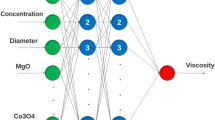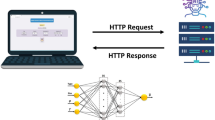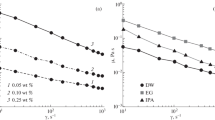Abstract
This paper applies the model including back-propagation network (BPN) and principal component analysis (PCA) to estimate the effective viscosity of carbon nanotubes suspension. The effective viscosities of multiwall carbon nanotubes suspension are examined as a function of the temperature, nanoparticle volume fraction, effective length of nanoparticle and the viscosity of base fluids using artificial neural network. The obtained results by BPN–PCA model have good agreement with the experimental data.










Similar content being viewed by others
References
Eastman JA, Choi SUS, Li S, Yu W, Thompson LJ (2001) Anoma-lously increased effective thermal conductivities of ethylene glycol-based nanofluids containing copper nanoparticles. Appl Phys Lett 78:718–720
Xuan Y, Li Q (2000) Heat transfer enhancement of nanofluids. Int J Heat Fluid Flow 21:58–64
Jang SP, Choi SUS (2004) Role of brownian motion in the enhanced thermal conductivity of nanofluids. Appl Phys Lett 84:4316–4318
Maxwell JC (1904) A treatise on electricity and magnetism, 3rd edn. Clarendon Press, Oxford
Sohn CW, Chen MM (1981) Microconvective thermal conductivity in disperse two phase mixture as observed in a low velocity Couette flow experiment. J Heat Transf Trans ASME 103:47–51
Nguyen CT, Desgranges F, Roy G, Galanis N, Maré T (2007) Temperature and particles-size dependent viscosity data for water-based nanofluids—Hysteresis phenomenon. Int J Heat Fluid Flow 28:1492–1506
Maré T, Halelfadl S, Sow O, Estellé P, Duret S, Bazantay F (2011) Comparison of the thermal performances of three nanofluids at low temperature in a plate heat exchanger. Exp Therm Fluid Sci 35:1535–1543
Ferrouillat S, Bontemps A, Ribeiro JP, Gruss JA, Soriano O (2011) Hydraulic and heat transfer study of SiO2/water nanofluids in horizontal tubes with imposed wall temperature boundry conditions. Int J Heat Fluid Flow 32:424–439
Wang X, Choi SUS (1999) Thermal conductivity of nanoparticle–fluid mixture. J Thermophys Heat Transf 13:474–480
Chevalier J, Tillement O, Ayela F (2007) Rheogical properties of nanofluids flowing through microchannels. Appl Phys Lett 91:233103
Chen HS, Ding YL, Tan CQ (2007) Rheological behaviour of nanofluids. New J Phys 9:1–25
Chen HS, Ding YL, Lapkin A, Fan X (2009) Rheological behavior of ethylene glycol-titanate nanotube nanofluids. J Nanopart Res 11:1513–1520
Kulkarni DP, Debendra KD, Ravikanth SV (2009) Application of nanofluids in heating buildings and reducing pollution. Appl Energy 86:2566–2573
Kole M, Dey TK (2010) Thermal conductivity and viscosity of Al2O3 nanofluid based on car engine coolant. J Phys D Appl Phys 43:315501
Einstein A (1906) Einene uebestimmung der molekul dimensionen. Ann Phys 19:289–306
Batchelor GK (1977) The effect of Brownian motion on the bulk stress in the suspension of spherical particles. J Fluid Mech 83:97–117
Masoumi N, Sohrabi N, Behzadmehr A (2009) A new model for calculating the effective viscosity of nanofluids. J Phys D Appl Phys 42:055501–055507
Hosseini MS, Mohebbi A, Ghader S (2010) Correlation of shear viscosity of nanofluids using the local composition theory. Chin J Chem Eng 18:102–110
Nguyen CT, Desgranges F, Galanis N, Roy G, Mare T, Boucher S, Angue Mintsa H (2008) Viscosity data for Al2O3–water nanofluid-hysteresis: is heat transfer enhancement using nanofluids reliable. Int J Therm Sci 47:103–111
Maiga SEB, Nguyen CT, Galanis N, Roy G (2004) Heat transfer behaviors of nanofluids in a uniformly heated tube. Superlattices Microstruct 35:543–557
Kulkarni DP, Das DK, Chukwu G (2006) Temperature dependent rheological property of copper oxide nanoparticles suspension (Nanofluid). J Nanosci Nanotechnol 6:1150–1154
Yousefi F, Karimi H, Papari MM (2012) Modeling viscosity of nanofluids using diffusional neural networks. J Mol Liq 175:85–90
Karimi H, Yousefi F (2012) Application of artificial neural network–genetic algorithm (ANN–GA) to correlation of density in nanofluid. Fluid Phase Equilib 336:79–83
Sablani SS, Kacimov A, Perret J, Mujumdar AS, Campo A (2005) Non-iterative estimation of heat transfer coefficients using neural network models. Int J Heat Mass Transf 48:665–790
Kurt H, Atik K, Ozkaymak M, Binark AK (2006) The artificial neural network approach for evolution of temperature and density profiles of salt gradient solar pond. J Energy Inst 80:46–51
Papari MM, Yousefi F, Moghadasi J, Karimi H, Campo A (2011) Modeling thermal conductivity augmentation of nanofluids using diffusion neural networks. Int J Therm Sci 50:44–52
Yousefi F, Karimi H, Gomar M (2013) Ability of analytical and artificial approaches for prediction of the volumetric properties of some polymer blends. Fluid Phase Equilib 355:92–98
Yousefi F, Karimi H (2013) Application of equation of state and artificial neural network to prediction of volumetric properties of polymer melts. J Ind Eng Chem 19:498–507
Yousefi F, Karimi H (2012) P-V–T properties of polymer melts based on equation of state and neural network. Eur Polym J 48:1135–1143
Yousefi F, Karimi H, Gandomkar Z (2014) Equation of state and artificial neural network to predict the thermodynamic properties of pure and mixture of liquid alkali metals. Fluid Phase Equilib 370:43–49
Yousefi F, Karimi H, Alekasir E, Shishebor M (2015) Prediction of thermodynamic behavior of copolymers using equation of state and artificial neural network. Colloid Polym Sci 293:75–87
Chauhan D, Singhvi N, Singh R (2013) Dependence of effective thermal conductivity of composite materials on the size of fillerparticles. J Reinf Plast Compos 32:1323–1330
Ahadian S, Hiroshi M, Yoshiyuki K (2011) Effects of hydration level, temperature, side chain and backbone flexibility of the polymer on the proton transfer in short-side-chain perfluorosulfonic acid membranes at low humidity conditions. J Membr Sci 369:339–349
Xinliang Y, Xueye W, Bo L (2010) Prediction of the Q-e parameters rom radical structures. Colloid Polym Sci 288:951–958
Xinliang Y, Bing Y, Fang L et al (2008) Prediction of the dielectric dissipation factor tan delta of polymers with an ANN model based on the DFT calculation. React Funct Polym 68:1557–1562
Zhang Z, Fried K (2003) Artificial neural networks applied to polymer composites: a review. Compos Sci Technol 63:2029–2044
Khajeh A, Modarress H (2010) Prediction of solubility of gases in polystyrene by adaptive neuro-fuzzy inference system and radial basis function neural network. Expert Syst Appl 37:3070–3074
Gharagheizi F, Salehi GR (2011) Prediction of enthalpy of fusion of pure compounds using an artificial neural network-group contribution method. Thermochim Acta 52137–40
Sencan A, Ilke Köse I, Selbas R (2011) Prediction of thermophysical properties of mixed refrigerants using artificial neural network. Energy Convers Manag 52:958–974
Poole CP, Owens FJ (2003) Introduction to Nanothechnology. Wiley, Hoboken
Iijima S (1991) Helical microtubules of graphitic carbon. Nature 354:56–58
Dresselhaus MS, Dresselhaus G, Avouris P (2001) Carbon nanotubes: synthesis, properties, and applications. Springer, Berlin
Huang JY, Chen S, Wang ZQ, KempaK Wang YM, Jo SH, Chen G, Dresselhaus MS, Ren ZF (2006) Superplastic single-walled carbon nanotubes. Nature 439:281
Van der SmagtP P (1994) Minimization methods for training feed forward neural network. Neural Netw 7:1994
Huang CF, Moraga C (2004) A diffusion-neural-network for learning from small samples. Int J Approx Reason 35:137–161
Lanouette R, Thibault J, Valade JL (1999) Process modeling with neural networks using small experimental datasets. Comput Chem Eng 23:1167–1176
Wang X, Paliwal KK (2003) Feature extraction and dimensionality reduction algorithms and their applications in vowel recognition. J Pattern RecognSoc 36:2429–2439
Smith Lindsay I (2002) A tutorial on principal components analysis. http://kybele.psych.cornell.edu/~edelman/Psych-465Spring-2003/PCA-tutorial
Kumaresan V, Velraj R (2012) Experimental investigation of the thermo-physical properties of water–ethylene glycol mixture based CNT nanofluids. Thermochim Acta 545:180–186
Chen Lifei, Xie Huaqing, Li Yang, Wei Yu (2008) Nanofluids containing carbon nanotubes treated by mechanochemical reaction. Thermochim Acta 477:21–24
Halelfadl S, Estellé P, Aladag B, Doner N, Maré Th (2013) Viscosity of carbon nanotubes water based nanofluids: influence of concentration and temperature. Int J Therm Sci 71:111–117
Liu ZH, Yang XF, Xiong JG (2010) Boiling characteristics of carbon nanotube suspensions under sub-atmospheric pressures. Int J Therm Sci 49:1156–1164
Jyothirmayee Aravind SS, Baskar P, Th Baby T, Sabareesh RK, Das S, Ramaprabhu S (2011) Investigation of structural stability, dispersion, viscosity, and conductive heat transfer properties of functionalized carbon nanotube based nanofluids. J Phys Chem C 115(34):6737–6744
Einstein A (1906) Einenen uebestimmung der moleküldimensionen. Ann Phys 324(2):289–306
Brinkman HC (1952) The viscosity of concentrated suspensions and solutions. J Chem Phys 20:571–581
Batchelor G (1977) The effect of Brownian motion on the bulk stress in a suspension of spherical particles. J Fluid Mech 83:97–117
Cheng NS, Wing-Keung Law A (2003) Experimental formula for computing effecttive viscosity. J Powder Technol 129:156–160
Krieger IM, Dougherty TJ (1959) A mechanism for non-Newtonian flow in suspension of rigid spheres. J Trans Soc Rheol 3:137–152
Vand V (1948) Viscosity of solutions and suspensions. J Phys Colloid Chem Theory 52:277–299
Saito N (1950) Concentration dependence of the viscosity of high polymer solutions. J Phys Soc Jpn I 5:4–8
Lundgren TS (1972) Slow flow through stationary random beds and suspensions of spheres. J Fluid Mech 51(2):273–299
Karimi H, Yousefi F, Rahimi MR (2011) Correlation of viscosity in nanofluids using geneticalgorithm-neural network (GA-NN). Heat Mass Transf 47:1417–1425
Author information
Authors and Affiliations
Corresponding author
Rights and permissions
About this article
Cite this article
Yousefi, F., Karimi, H. & Mohammadiyan, S. Viscosity of carbon nanotube suspension using artificial neural networks with principal component analysis. Heat Mass Transfer 52, 2345–2355 (2016). https://doi.org/10.1007/s00231-015-1745-6
Received:
Accepted:
Published:
Issue Date:
DOI: https://doi.org/10.1007/s00231-015-1745-6




